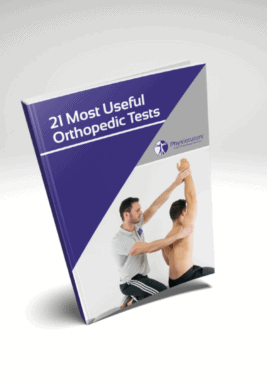Learn
Lemaire Jolt test | Anteromedial Rotatory Instability
Lemaire (1967) described this test as a great test to confirm ruptures of the anterior cruciate ligament in the anesthetized patient. However, he noted that it’s hard to elicit anterolateral rotatory instability in the awake patient as patients can’t fully relax. Furthermore, this test hasn’t been assessed on its diagnostic ability so the clinical value is questionable.
To conduct the test, the patient lies in supine position. Standing on the side to be examined, the leg is extended and brought into internal rotation by one hand that’s grasping the ankle. The dorsum of the other hand is placed behind the head of the fibula and tendon of the biceps femoris in order to apply a ventrally directed force. The patient is asked to relax completely.
The knee is then gently flexed and extended repeatedly and the examiner observes for anteromedial subluxation of the tibia.
In the second step, the flexion angle is increased which will result in jolting backward of the tibia indicating a positive test.
21 OF THE MOST USEFUL ORTHOPAEDIC TESTS IN CLINICAL PRACTICE

Other common tests to assess for rotatory instability of the knee are:
- Slocum Test (Anterolateral Rotatory Instability)
- Giving Way Test of Jakob (Anterolateral Rotatory Instability)
- Crossover Test of Arnold (Anterolateral Rotatory Instability)
- Reverse Pivot-Shift Test (Posterolateral Rotatory Instability)
- Dial Test (Posterolateral Rotatory Instability)
- Frog Leg Test (Posterolateral Rotatory Instability)
Like what you’re learning?
BUY THE FULL PHYSIOTUTORS ASSESSMENT BOOK
- 600+ Pages e-Book
- Interactive Content (Direct Video Demonstration, PubMed articles)
- Statistical Values for all Special Tests from the latest research
- Available in 🇬🇧 🇩🇪 🇫🇷 🇪🇸 🇮🇹 🇵🇹 🇹🇷
- And much more!








